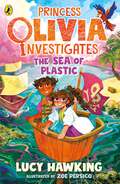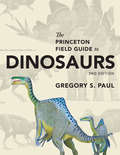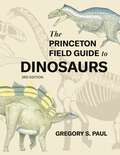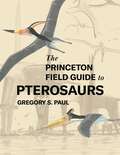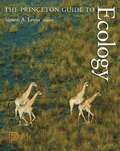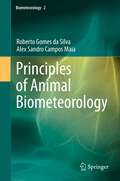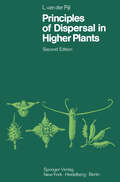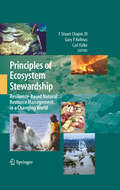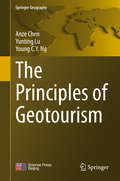- Table View
- List View
Princess Olivia Investigates: The Sea of Plastic (Princess Olivia Investigates)
by Lucy HawkingEveryone talks about how powerful the oceans are, how huge, how mysterious, all those underwater creatures living down there in the deep. But they've got no one to stand up for them!Olivia Alez is loving her life away from the royal palace. Now she isn't a princess anymore she's even more determined to be a science investigator, finding out things about the world around her.When she goes to visit her uncle Cassander for a holiday, she realises there's a huge problem. The oceans are filled with rubbish, and she can't see any fish swimming about. They're nothing like the bright blue seas full of life that she's seen before.When Captain Max and his parrot turn up, Olivia and her best friend Ravi decide that getting on board their pirate ship as they hunt for treasure might be a good way to find out what's going on in the water. But they quickly realise that they've got more to discover than they ever imagined . . .
Princess Olivia Investigates: The Wrong Weather (Princess Olivia Investigates)
by Lucy HawkingThe brand new series for young readers from bestselling author Lucy Hawking.'The more we find out about the world around us, the more we can work out other, more complicated things, such as how the universe began or how life got started on Earth . . .'Olivia Alez is delighted about finally living a life away from the royal palace in the mountains that used to be her home, after the Kingdom of Alez decides it doesn't want a royal family any more. Now she can finally give up boring princess lessons and learn about real things, like volcanoes and the ocean and space!But Olivia is completely unprepared for the world that awaits her. Thick, dark clouds hang low over the city, and the rivers that she so longed to see are choked with rubbish. And on top of it all, the weather just feels wrong. With scorching hot sun one day and torrential rainfall the next, it seems nearly impossible for the people and animals in Alez to adapt to their extreme climate.Olivia, horrified by what she sees, becomes determined to get to the bottom of Alez's dangerous weather patterns. With the help of some new friends and armed with a scientific lab coat that would make Albert Einstein jealous, Olivia sets out to solve the mystery and save Alez from climate destruction before it's too late . . .
The Princeton Field Guide to Dinosaurs: Second Edition
by Gregory S. PaulThe best-selling Princeton Field Guide to Dinosaurs remains the must-have book for anyone who loves dinosaurs, from amateur enthusiasts to professional paleontologists. Now extensively revised and expanded, this dazzlingly illustrated large-format edition features some 100 new dinosaur species and 200 new and updated illustrations, bringing readers up to the minute on the latest discoveries and research that are radically transforming what we know about dinosaurs and their world.Written and illustrated by acclaimed dinosaur expert Gregory Paul, this stunningly beautiful book includes detailed species accounts of all the major dinosaur groups as well as nearly 700 color and black-and-white images—skeletal drawings, "life" studies, scenic views, and other illustrations that depict the full range of dinosaurs, from small feathered creatures to whale-sized supersauropods. Paul's extensively revised introduction delves into dinosaur history and biology, the extinction of nonavian dinosaurs, the origin of birds, and the history of dinosaur paleontology, as well as giving a taste of what it might be like to travel back in time to the era when dinosaurs roamed the earth.Now extensively revised and expandedCovers nearly 750 dinosaur species, including scores of newly discovered onesProvides startling new perspectives on the famed Brontosaurus and TyrannosaurusFeatures nearly 700 color and black-and-white drawings and figures, including life studies, scenic views, and skull and muscle drawingsIncludes color paleo-distribution maps and a color time lineDescribes anatomy, physiology, locomotion, reproduction, and growth of dinosaurs, as well as the origin of birds and the extinction of nonavian dinosaurs
The Princeton Field Guide to Dinosaurs Third Edition (Princeton Field Guides #69)
by Gregory S. PaulA fully updated and expanded edition of the acclaimed, bestselling dinosaur field guideThe bestselling Princeton Field Guide to Dinosaurs remains the must-have book for anyone who loves dinosaurs, from amateur enthusiasts to professional paleontologists. Now extensively revised and expanded, this dazzlingly illustrated large-format edition features nearly 100 new dinosaur species and hundreds of new and updated illustrations, bringing readers up to the minute on the latest discoveries and research that are radically transforming what we know about dinosaurs and their world.Written and illustrated by acclaimed dinosaur expert Gregory Paul, this stunningly beautiful book includes detailed species accounts of all the major dinosaur groups as well as a wealth of breathtaking images—skeletal drawings, &“life&” studies, scenic views, and other illustrations that depict the full range of dinosaurs, from small feathered creatures to whale-sized supersauropods. Paul&’s extensive introduction delves into dinosaur history and biology, the extinction of nonavian dinosaurs, the origin of birds, and the history of dinosaur paleontology, and also gives a taste of what it might be like to travel back in time to the era when dinosaurs roamed the earth.Now covers more than 800 dinosaur species, including scores of newly discovered onesProvides startling perspectives on the famed Brontosaurus and TyrannosaurusReveals that the largest dinosaurs weighed as much as the biggest whales, and shows why that happenedFeatures hundreds of color and black-and-white drawings and figures, including life studies, scenic views, and skull and muscle drawingsIncludes color paleo-distribution maps and a color time lineDescribes anatomy, physiology, locomotion, reproduction, and growth of dinosaurs, as well as the origin of birds and the extinction of nonavian dinosaurs
The Princeton Field Guide to Pterosaurs (Princeton Field Guides #155)
by Gregory S. PaulThe most up-to-date and authoritative illustrated guide to the marvelous flying reptiles that dominated the skies of the Mesozoic for 160 million yearsOnce seen by some as evolutionary dead-enders, pterosaurs were vigorous winged reptiles capable of thriving in an array of habitats and climates, including polar winters. The Princeton Field Guide to Pterosaurs transforms our understanding of these great Mesozoic archosaurs of the air. This incredible guide covers 115 pterosaur species and features stunning illustrations of pterosaurs ranging in size from swallows to small sailplanes, some with enormous, bizarre head crests and elongated beaks. It discusses the history of pterosaurs through 160 million years of the Mesozoic—including their anatomy, physiology, locomotion, reproduction, growth, and extinction—and even gives a taste of what it might be like to travel back to the Mesozoic. This one-of-a-kind guide also challenges the common image of big pterosaurs as ultralights that only soared, showing how these spectacular creatures could be powerful flappers as heavy as bears.Features detailed species accounts of 115 different kinds of pterosaurs, with the latest size and mass estimatesWritten and illustrated by the acclaimed researcher and artist who helped to redefine the anatomy and flight performance of pterosaursCovers everything from pterosaur biology to the colorful history of pterosaur paleontologyIncludes dozens of original skeletal drawings and full-color life studies
The Princeton Guide to Ecology
by Simon A. Levin Stephen R. Carpenter H. Charles Godfray Ann P. Kinzig Michel Loreau Jonathan B. Losos Brian Walker David S. WilcoveThe Princeton Guide to Ecology is a concise, authoritative one-volume reference to the field's major subjects and key concepts. Edited by eminent ecologist Simon Levin, with contributions from an international team of leading ecologists, the book contains more than ninety clear, accurate, and up-to-date articles on the most important topics within seven major areas: autecology, population ecology, communities and ecosystems, landscapes and the biosphere, conservation biology, ecosystem services, and biosphere management. Complete with more than 200 illustrations (including sixteen pages in color), a glossary of key terms, a chronology of milestones in the field, suggestions for further reading on each topic, and an index, this is an essential volume for undergraduate and graduate students, research ecologists, scientists in related fields, policymakers, and anyone else with a serious interest in ecology. Explains key topics in one concise and authoritative volume Features more than ninety articles written by an international team of leading ecologists Contains more than 200 illustrations, including sixteen pages in color Includes glossary, chronology, suggestions for further reading, and index Covers autecology, population ecology, communities and ecosystems, landscapes and the biosphere, conservation biology, ecosystem services, and biosphere management
The Princeton Guide to Ecology
by Simon A. Levin Stephen R. Carpenter H. Charles Godfray Ann P. Kinzig Michel Loreau Jonathan B. Losos Brian Walker David S. WilcoveThe Princeton Guide to Ecology is a concise, authoritative one-volume reference to the field's major subjects and key concepts. Edited by eminent ecologist Simon Levin, with contributions from an international team of leading ecologists, the book contains more than ninety clear, accurate, and up-to-date articles on the most important topics within seven major areas: autecology, population ecology, communities and ecosystems, landscapes and the biosphere, conservation biology, ecosystem services, and biosphere management. Complete with more than 200 illustrations (including sixteen pages in color), a glossary of key terms, a chronology of milestones in the field, suggestions for further reading on each topic, and an index, this is an essential volume for undergraduate and graduate students, research ecologists, scientists in related fields, policymakers, and anyone else with a serious interest in ecology. Explains key topics in one concise and authoritative volume Features more than ninety articles written by an international team of leading ecologists Contains more than 200 illustrations, including sixteen pages in color Includes glossary, chronology, suggestions for further reading, and index Covers autecology, population ecology, communities and ecosystems, landscapes and the biosphere, conservation biology, ecosystem services, and biosphere management
Principal Component Regression for Crop Yield Estimation (SpringerBriefs in Applied Sciences and Technology)
by T.M.V. Suryanarayana P.B. MistryThis book highlights the estimation of crop yield in Central Gujarat, especially with regard to the development of Multiple Regression Models and Principal Component Regression (PCR) models using climatological parameters as independent variables and crop yield as a dependent variable. It subsequently compares the multiple linear regression (MLR) and PCR results, and discusses the significance of PCR for crop yield estimation. In this context, the book also covers Principal Component Analysis (PCA), a statistical procedure used to reduce a number of correlated variables into a smaller number of uncorrelated variables called principal components (PC). This book will be helpful to the students and researchers, starting their works on climate and agriculture, mainly focussing on estimation models. The flow of chapters takes the readers in a smooth path, in understanding climate and weather and impact of climate change, and gradually proceeds towards downscaling techniques and then finally towards development of principal component regression models and applying the same for the crop yield estimation.
The Principle of Sustainability: Transforming law and governance
by Klaus BosselmannThis book investigates how sustainability informs key principles and concepts of domestic and international law. It calls for the recognition of ecological sustainability as a fundamental principle to guide the entire legal system rather than just environmental legislation. To this end, the book makes a contribution to global environmental constitutionalism, a rapidly growing area within comparative and international environmental law and constitutional law. This 2nd edition has been fully revised and updated to take account of recent developments and new case law. The book will be a valuable resource for students, researchers and policy makers working in the areas of environmental law and governance.
The Principle of Sustainability: Transforming law and governance
by Klaus BosselmannThis book investigates how sustainability informs key principles and concepts of domestic and international law. It calls for the recognition of ecological sustainability as a fundamental principle to guide the entire legal system rather than just environmental legislation. To this end, the book makes a contribution to global environmental constitutionalism, a rapidly growing area within comparative and international environmental law and constitutional law. This 2nd edition has been fully revised and updated to take account of recent developments and new case law. The book will be a valuable resource for students, researchers and policy makers working in the areas of environmental law and governance.
Principles and Methods in Landscape Ecology
by A. FarinaCurrently considered a bridge between basic and Twopossibilities exist to expand landscape ecol applied ecology, landscape ecology occupies an ogy: one consists of developing new research, and important new niche in ecology,representing a new the other in developing a good educational frame star in the galaxy of the ecological sciences. work. Both are important and not in conflict. In this However, the broad spectrum of conceptual and spirit I have prepared this book, with the aim of methodological approaches has created a non summarizing the best theories, concepts, principles focused science strongly influenced by the more and methods in landscape ecology. It is an attempt dominant disciplines, such as landscape planning to reinforce the ecological research perspective, to and restoration, forest management, landscape consolidate principles and methods, validate proce architecture etc. dures and reconcile different positions, including The uncertain position of landscape ecology the geobotanic, animal and human perspectives. among the ecological disciplines is in contradiction The concept is very simple. I have no ambition with the general recognition that landscape is a spa to present new ideas and theories: I have worked to tial dimension in which important ecological create a tool mainly for classroom use but also processes occur, and landscape is becoming very appealing to a broad range of scientists and practi popular in many ecology-related fields, from plant tioners dealing with landscape ecology and its disease to animal behaviour. problems.
Principles and Practices of Aquatic Law
by John Robert FletemeyerPrinciples and Practices of Aquatic Law presents the best practices and principles related to aquatic law and risk management. Its focus is injury and death occurring in aquatic environments including the ocean, pools, water parks, canals, rivers, lakes, dams, etc. It discusses the importance of aquatic risk management as it relates to aquatic accident prevention and the concept of duty and liability for a facility’s management and staff. It also presents updated and relevant information about beach safety and the importance of hazard identification, warning, and elimination, and provides information for attorneys relating to the process of developing liability theories involving serious aquatic accidents and death. Features Presents a comprehensive resource on the applied practices and principles of aquatic law. Provides information for attorneys for the process of developing liability theories involving serious aquatic accidents and death. Presents updated and relevant information about beach safety and the importance of hazard identification, warning, and elimination. Discusses water-borne contaminants such as cryptosporidium and flesh-eating bacteria. Presents comprehensive public safety and beach management strategies: rip current prediction and monitoring, coastal engineering, drowning and rescue statistics, etc.
Principles and Practices of Aquatic Law
by John Robert FletemeyerPrinciples and Practices of Aquatic Law presents the best practices and principles related to aquatic law and risk management. Its focus is injury and death occurring in aquatic environments including the ocean, pools, water parks, canals, rivers, lakes, dams, etc. It discusses the importance of aquatic risk management as it relates to aquatic accident prevention and the concept of duty and liability for a facility’s management and staff. It also presents updated and relevant information about beach safety and the importance of hazard identification, warning, and elimination, and provides information for attorneys relating to the process of developing liability theories involving serious aquatic accidents and death. Features Presents a comprehensive resource on the applied practices and principles of aquatic law. Provides information for attorneys for the process of developing liability theories involving serious aquatic accidents and death. Presents updated and relevant information about beach safety and the importance of hazard identification, warning, and elimination. Discusses water-borne contaminants such as cryptosporidium and flesh-eating bacteria. Presents comprehensive public safety and beach management strategies: rip current prediction and monitoring, coastal engineering, drowning and rescue statistics, etc.
Principles of Agronomy for Sustainable Agriculture
by Francisco J. Villalobos Elias FereresThis textbook explains the various aspects of sustainable agricultures to undergraduate and graduate students. The book first quantifies the components of the crop energy balance, i.e. the partitioning of net radiation, and their effect on the thermal environment of the canopy. The soil water balance and the quantification of its main component (evapotranspiration) are studied to determine the availability of water to rain fed crops and to calculate crop water requirements. Then it sets the limitations of crop production in relation to crop phenology, radiation interception and resource availability (e.g. nutrients). With that in mind the different agricultural techniques (sowing, tillage, irrigation, fertilization, harvest, application of pesticides, etc.) are analyzed with special emphasis in quantifying the inputs (sowing rates, fertilizer amounts, irrigation schedules, tillage plans) required for a given target yield under specific environmental conditions (soil & climate). For all techniques strategies are provided for improving the ratio productivity/resource use while ensuring sustainability. The book comes with online practical focusing on the key aspects of management in a crop rotation (collecting weather data, calculating productivity, sowing rates, irrigation programs, fertilizers rates etc).
Principles of Alluvial Fan Morphology
by Dan BowmanThis book offers a comprehensive overview of the alluvial fan phenomena, including all terminology, morphology, sedimentology, controlling factors, processes and the human impact. It combines the knowledge dispersed widely in existing literature with regional case studies, color figures and photographs. The chapters provide a useful basis to understand alluvial fans and a selection of papers attached to each chapter offers additional, more focused reading. This volume is aimed at engineers, planners and especially students in earth sciences.
Principles of Animal Biometeorology (Biometeorology #2)
by Roberto Gomes da Silva Alex Sandro Campos MaiaThe book begins by describing in detail the mechanisms of energy exchange – radiative, convective, conductive and evaporative – together with techniques for their determination. The discussion extends to the importance of CO2, ozone and methane, together with that of aerosol pollutants and the evolution of atmospheric CO2. Subsequent chapters apply the results of the biophysical methods to mammals, birds and aquatic animals. Discussion includes problems of shelter and shade for animals in tropical environments and techniques for the thermal evaluation for shelters and for several tree types. The details of heat exchange between animals and the environment are presented, in separate chapters covering Mammals and Birds and Aquatic Mammals. A chapter on Shade and Shelter describes the importance of shade for animals, factors of shade efficiency, the protections offered by shelter and methods of calculating the protection afforded by both shade and shelter. A Special Methods chapter offers a variety of techniques for evaluating cutaneous and respiratory evaporation, and practical methods for sampling of hairs and the evaluation of hair coat characteristics.
Principles of direct and superior responsibility in international humanitarian law (Melland Schill Studies in International Law)
by Ilias BantekasNow available as an ebook for the first time, Bantekas's 2002 title on the forms of criminal responsibility arising from violations of international humanitarian law examines the evolution of personal responsibility and its contemporary application to war crimes, crimes against humanity and genocide. It traces the origin and development of such concepts as direct participation, ordering, complicity and inciting. The work includes extensive analysis of the jurisprudence of the International Criminal Tribunals for Yugoslavia and Rwanda and the International Criminal Court, as well as a variety of other legal material. Hans-Peter Gasser, then editor of the International Review of the Red Cross, describes the book in his Foreword as 'an invaluable contribution to a better understanding of the role that criminal law can play in efforts to enhance respect for the rights of victims of violence and war'. This title in the Melland Schill Studies in International Law series is a useful text for all those who wish to understand the principles of criminal responsibility in international humanitarian law.
Principles of direct and superior responsibility in international humanitarian law (Melland Schill Studies in International Law)
by Ilias BantekasNow available as an ebook for the first time, Bantekas's 2002 title on the forms of criminal responsibility arising from violations of international humanitarian law examines the evolution of personal responsibility and its contemporary application to war crimes, crimes against humanity and genocide. It traces the origin and development of such concepts as direct participation, ordering, complicity and inciting. The work includes extensive analysis of the jurisprudence of the International Criminal Tribunals for Yugoslavia and Rwanda and the International Criminal Court, as well as a variety of other legal material. Hans-Peter Gasser, then editor of the International Review of the Red Cross, describes the book in his Foreword as 'an invaluable contribution to a better understanding of the role that criminal law can play in efforts to enhance respect for the rights of victims of violence and war'. This title in the Melland Schill Studies in International Law series is a useful text for all those who wish to understand the principles of criminal responsibility in international humanitarian law.
Principles of Dispersal in Higher Plants
by L. van PijlReviewers from diverse branches of botany have exerted pressure to have chapters dealing with their field extended. If only to cover his incompetence, the author could not accede to these requests. Nor was it possible to respond to Eastern European urgings to extend the classificatory terminology, especially in ChapterX. He is grateful for indications of factual shortcomings in the chosen field, especially for those by Dr. RUDOLF SCHMID (Ann Arbor), who provided exten sive comment. L. VAN DER PIlL The Hague, spring 1972 Preface to the First Edition The work offered here is a companion volume to the work by K. FAEGRI and 1. VAN DER PIJL, Principles of Pollination Ecology, whim. deals with the preced ing phase of reproduction in plants. In the present work too, the emphasis is on principles and ecology. It is neither an enumeration of mechanisms, nor a compilation of cases. RIDLEY'S monumental work The Dispersal of Plants Throughout the World comprises 700 large pages of small print, and research has proceeded since then. Though this work is more than just a compilation and contains much insight and thoughts on principles in addition to reviews, its completeness hinders its use as a text book. As a reference work, it is unsurpassed and the writer made frequent use of it. The writer paid special attention to functional backgrounds for the use of taxonomists working with "characters" and to biosystematics at the macro-level.
Principles of Ecosystem Stewardship: Resilience-Based Natural Resource Management in a Changing World
by M. C. ChapinThe world is undergoing unprecedented changes in many of the factors that determine its fundamental properties and their in- ence on society. These changes include climate; the chemical c- position of the atmosphere; the demands of a growing human population for food and ?ber; and the mobility of organisms, ind- trial products, cultural perspectives, and information ?ows. The magnitude and widespread nature of these changes pose serious challenges in managing the ecosystem services on which society depends. Moreover, many of these changes are strongly in?uenced by human activities, so future patterns of change will continue to be in?uenced by society’s choices and governance. The purpose of this book is to provide a new framework for n- ural resource management—a framework based on stewardship of ecosystems for human well-being in a world dominated by unc- tainty and change. The goal of ecosystem stewardship is to respond to and shape change in social-ecological systems in order to s- tain the supply and opportunities for use of ecosystem services by society. The book links recent advances in the theory of resilience, sustainability, and vulnerability with practical issues of ecosystem management and governance. The book is aimed at advanced undergraduates and beginning graduate students of natural resource management as well as professional managers, community leaders, and policy makers with backgrounds in a wide array of d- ciplines, including ecology, policy studies, economics, sociology, and anthropology.
The Principles of Geotourism (Springer Geography)
by Anze Chen Yunting Lu Young C.Y. NgThe book introduces tourism earth-science as a new scientific discipline by applying the principles of earth-science in the study of natural and human tourism resources. It involves studying the geo-scientific characteristics of these tourism resources through surveys, evaluation and aesthetic value assessment. It also discusses about the principles behind geopark establishment and management. It is an important publication providing direction for geopark and tourism developments in China. The book is a tool for geological heritage survey, assessment and research. It can also be used to assist planning of geopark, national parks, heritage protection and scientific interpretation. It is a valuable teaching material for teachers and students of geoscience and tourism as well as providing useful guidance for geopark managers and tour guides in their operation. In addition, the book also offers scientific knowledge of the surrounding natural and cultural landscapes to the public and the general visitors.
Principles of International Energy Transition Law
by Frédéric G. Sourgens Leonardo SemperteguiEnergy transition is a complex global problem, with governance and policies cutting across multiple legal silos including human rights, environment, international economics, finance, energy, law of the sea, and transnational commerce. As of yet, there is no comprehensive treatment of the legal principles governing energy transition as a whole. Furthermore, energy transition must solve a trilemma that pits energy equity (the need to provide access to energy needed to fuel human development) and energy security (the need to provide resilient and reliable energy systems) against environmental sustainability. Without a comprehensive understanding of these issues, law and policy-makers risk exacerbating rather than resolving the underlying problems. Principles of International Energy Transition Law introduces the energy transition problem by situating the climate emergency in its broader energy and development context, showing how global energy value chains are deeply enmeshed in and drive global economic and human development. It combines the different legal perspectives in one consistent analysis by outlining their interactions and showing how they can be reconciled. The book discusses thirty-two international legal principles governing different aspects of the energy transition trilemma's three parts. It then uses a commons governance perspective to propose a holistic approach to applying and balancing these different parts and their different legal principles. Highlighted sections summarise the most important concepts and ideas for easy reference, making the title particularly accessible for students and policy-makers as well as law practitioners.
Principles of International Energy Transition Law
by Frédéric G. Sourgens Leonardo SemperteguiEnergy transition is a complex global problem, with governance and policies cutting across multiple legal silos including human rights, environment, international economics, finance, energy, law of the sea, and transnational commerce. As of yet, there is no comprehensive treatment of the legal principles governing energy transition as a whole. Furthermore, energy transition must solve a trilemma that pits energy equity (the need to provide access to energy needed to fuel human development) and energy security (the need to provide resilient and reliable energy systems) against environmental sustainability. Without a comprehensive understanding of these issues, law and policy-makers risk exacerbating rather than resolving the underlying problems. Principles of International Energy Transition Law introduces the energy transition problem by situating the climate emergency in its broader energy and development context, showing how global energy value chains are deeply enmeshed in and drive global economic and human development. It combines the different legal perspectives in one consistent analysis by outlining their interactions and showing how they can be reconciled. The book discusses thirty-two international legal principles governing different aspects of the energy transition trilemma's three parts. It then uses a commons governance perspective to propose a holistic approach to applying and balancing these different parts and their different legal principles. Highlighted sections summarise the most important concepts and ideas for easy reference, making the title particularly accessible for students and policy-makers as well as law practitioners.
Principles Of International Environmental Law
by Philippe Sands Jacqueline Peel Adriana Fabra Ruth MacKenzieThis new and fully updated edition of Principles of International Environmental Law offers a comprehensive and critical account of one of the fastest growing areas of international law: the principles and rules relating to environmental protection. Introducing the reader to the key foundational principles, governance structures and regulatory techniques, Principles of International Environmental Law explores each of the major areas of international environmental regulation through substantive chapters, including climate change, atmospheric protection, oceans and freshwater, biodiversity, chemicals and waste regulation. The ever-increasing overlap with other areas of international law is also explored through examination of the inter-linkages between international environmental law and other areas of international regulation, such as trade, human rights, humanitarian law and investment law. Incorporating the latest developments in treaty and case law for key areas of environmental regulation, this text is an essential reference and textbook for advanced undergraduate and postgraduate students, academics and practitioners of international environmental law.
Principles of Plant Nutrition
by Konrad Mengel Ernest A. KirkbyThis is the 5th edition of a well-established book Principles of Plant Nutrition which was first published in 1978. The same format is maintained as in previous editions with the primary aim of the authors to consider major processes in soils and plants that are of relevance to plant nutrition.This new edition gives an up-to-date account of the scientific advances of the subject by making reference to about 2000 publications. An outstanding feature of the book, which distinguishes it from others, is its wide approach encompassing not only basic nutrition and physiology, but also practical aspects of plant nutrition involving fertilizer usage and crop production of direct importance to human nutrition. Recognizing the international readership of the book, the authors, as in previous editions, have attempted to write in a clear concise style of English for the benefit of the many readers for whom English is not their mother tongue. The book will be of use to undergraduates and postgraduates in Agriculture, Horticulture, Forestry and Ecology as well as those researching in Plant Nutrition.
